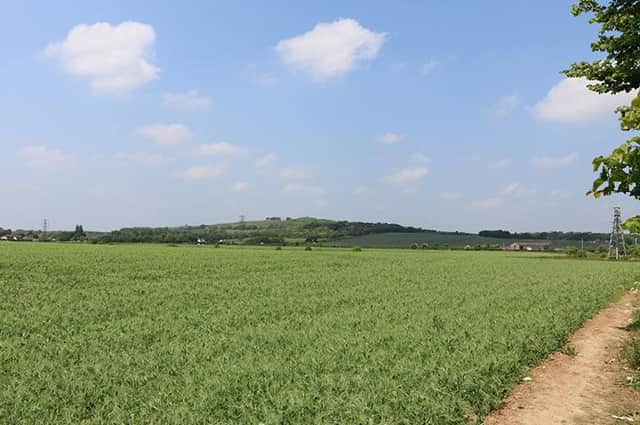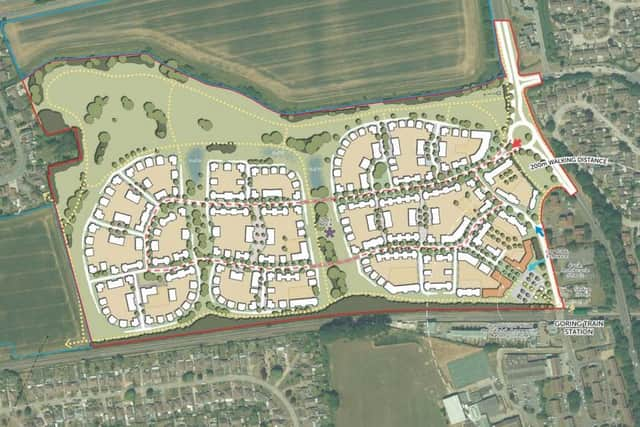Developer wins appeal over plans for 475 homes at Goring Gap


Persimmon Homes now has permission in principle to build 475 homes with parking, landscaping, and access in the form of a three-arm roundabout junction on land north-west of Goring-by-Sea railway station.
This follows a public inquiry last month where planning inspector Rory Cridland heard arguments from both the developer and Worthing Borough Council.
Advertisement
Hide AdAdvertisement
Hide AdThe area forms part of the ‘Goring Gap’ and the council fought the appeal to prevent the development from going ahead.


It considers the land an important area of green space which forms the boundary between Goring and other nearby settlements like Ferring.
There were also concerns that the development could adversely impact on the South Downs National Park and add to local traffic congestion.
At a meeting earlier this month, council leader Kevin Jenkins said: “This administration will fight for the residents to ensure that Chatsmore Farm, the Goring Gap, and Brooklands will not be developed on.
Advertisement
Hide AdAdvertisement
Hide Ad“As far as this administration is concerned, those gaps will not be built on – that is our pledge to the people of Worthing.”
The plans have caused concern among residents, local conservation groups, and Worthing West MP Sir Peter Bottomley who was present during the public inquiry.
Why has the appeal been allowed?
Although Worthing Borough Council’s planning committee rejected the development in March last year, Persimmon appealed the decision.
This led to an inquiry last month when a planning inspector was tasked with hearing evidence from both sides.
Advertisement
Hide AdAdvertisement
Hide AdThe council’s six reasons for refusal included the potential impact of the development on heritage assets like Highdown Hill; highway safety; potential impact on nesting birds; and concerns over infrastructure such as public open space and affordable housing.
But the planning inspector ruled that some of these were no longer valid as common ground had been found between WBC and Persimmon.
It was agreed that many of the council’s reasons for refusing the development could be resolved through planning conditions and a section 106 agreement has since been signed by both parties.
In his 22-page decision letter, planning inspector Rory Cridland said: “During the inquiry it became clear that the effect of the proposed development
Advertisement
Hide AdAdvertisement
Hide Adon local green space was inextricably linked to the acceptability of the location, the need for housing and the council’s emerging local plan.”
Mr Cridland acknowledged that it was ‘important to protect the areas of open
countryside which contribute to Worthing’s character’.
But the council’s failure to meet government housing targets and an ‘out of date’ core strategy worked in Persimmon’s favour, according to the planning inspector.
“It is clear that the unmet need for both market and affordable housing in Worthing is considerable,” he said, “At present, no solution has been identified.”
Advertisement
Hide AdAdvertisement
Hide AdWorthing Borough Council accepted that there was ‘substantial unmet need for affordable housing’ and, under national planning policy, a ‘presumption in favour of sustainable development’ now applies.
On highway concerns, the planning inspector said there would be ‘increased
congestion and travel time along parts of the highway network’ but added that the impact ‘would not be severe’.
Mr Cridland added that the development could have an ‘urbanising effect’ but that, because most of the buildings would be located at the southern end of the site, the overall visual impact would be ‘limited’.
Advertisement
Hide AdAdvertisement
Hide AdFor this reason, the planning inspector said the 475 homes would not have a ‘material effect’ on the national park or wider landscape.
Protections in local plan
Worthing Borough Council designated Chatsmore Farm as both a green gap and an area of local green space in its emerging local plan which will shape development over the next 15 years if adopted.
But Mr Cridland said the plan is ‘still some way off from adoption’ and, as such, the area ‘does not currently benefit from any formal protection’.
“While I agree that the site may be demonstrably special to the local community,” said Mr Cridland, “Chatsmore Farm constitutes an extensive tract of land and is unsuitable, as currently proposed, for local green space designation.”
Although the appeal was allowed, Persimmon will have to apply for full planning permission at a later stage.